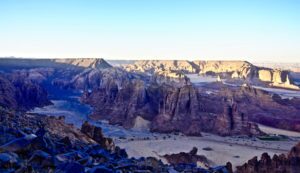
Editor’s Note: Like a rising phoenix, new evidence of ancient monumental civilizations is emerging from the desert of a modern Arabian kingdom. Below, through his own narrative, the Acting Executive Director of Collections for Saudi Arabia’s Royal Commission for AlUla relates the current efforts by officials and expert teams to discover, re-discover, and revitalize Saudi Arabia’s remarkable ancient heritage, gone unnoticed and uncelebrated to the rest of the world for far too long. In what is today northwest Saudi Arabia, and long before the rise of Islam, ancient monumental kingdoms created an astounding cultural florescence and dominated a landscape through which caravans of the incense trade and other goods enriched a land and its people………
Who was Dhu Ghabbat?
Was the primary deity of the ancient Lihyanites ‘the god of the forest’ as some scholars believe, or was he ‘the absentee’, as others assert?
We simply do not know for certain. We lack sufficient evidence. For too long, the archaeology of Arabia has been under-explored. Only in recent decades has the shortfall been addressed.
Today, Arabian archaeology is like a palace with missing pieces. Now we are finding those pieces, not just by excavating, but by the follow-up work of sorting, classifying and storing, as well. Piece by piece, we will acquire a clearer image of the palace’s structure. Eventually we will reach a point where our hunches become educated guesses and then solidify into working theories and finally accepted facts.
I work at the Royal Commission for AlUla (RCU) as Acting Executive Director of Collections. We are amid an enormous effort to regenerate 22,561 square kilometers of north-west Saudi Arabia. AlUla will become a world-class destination for natural and cultural heritage with flagship projects such as the Kingdoms Institute – a center for archaeological and conservation studies and a cultural platform for knowledge, exploration and inspiration.
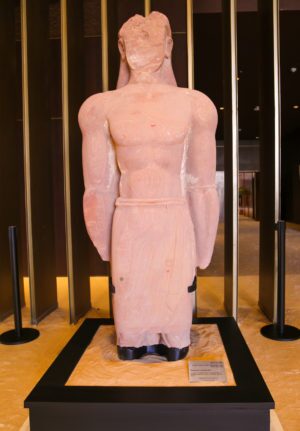 Already, well over 100 archaeologists are working across AlUla during fieldwork seasons and projects, shedding light on many past eras and revealing the depth and richness of AlUla’s cultural heritage. Our teams are uncovering more than 10,000 artifacts per year. Our storage units are growing rich with wonderful finds – from the minute (a unique leaf-shaped mother-of-pearl pendant found in a burial site dating to between 4300 and 3500 BCE) to the monumental (2.5m-tall statues of broad-shouldered kings excavated at Dadan dated to between the 5th and 3rd centuries BCE).
Already, well over 100 archaeologists are working across AlUla during fieldwork seasons and projects, shedding light on many past eras and revealing the depth and richness of AlUla’s cultural heritage. Our teams are uncovering more than 10,000 artifacts per year. Our storage units are growing rich with wonderful finds – from the minute (a unique leaf-shaped mother-of-pearl pendant found in a burial site dating to between 4300 and 3500 BCE) to the monumental (2.5m-tall statues of broad-shouldered kings excavated at Dadan dated to between the 5th and 3rd centuries BCE).
We are pursuing several projects to ensure the safe preservation of the treasures in our custody. As ambitious as we are to show the world our archaeological discoveries, this is also a time to be meticulous. We are careful with our riches to ensure that they can continue to be researched and enjoyed by future generations.
To begin, we are setting up a CMS (Collections Management System) database compatible with international standards to record and organize our data. We are increasing our storage capacity by building a facility at AlUla to the latest specifications and with capacity for more than 5,000 cases, and within three years we will have a new Collections Storage and Conservation Facility, developed for our art and heritage collections with state-of-the-art labs. We are issuing a Collections Handbook to ensure that all procedures for dealing with artifacts and artworks are controlled. And we are working to improve the quality of preservation and restoration of collections to ensure that they are not damaged in the future, especially during transportation to participate in exhibitions, regionally and globally, and at museums as well.
Working closely with our partners at the French Agency for the Development of AlUla (Afalula), we aspire to the match the excellence identified through internationally recognized institutions such as the British Museum in London, the Louvre in Paris, and the Getty in Los Angeles. As an organization, our aim is to work with the best cultural institutions and businesses, large or small, around the world to place RCU and the Kingdom of Saudi Arabia at the forefront of the community.
_________________________________

A Dadanite inscription. Zunkir, (CC BY-SA 4.0), Wikimedia Commons
_________________________________
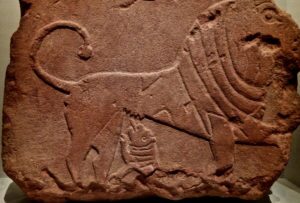
Dadanite bas relief of a lion. Sanctuaire de Dadan (al-Khuraybah), al-‘Ula. Daté des Ve-Ier siècles av. J.-C. Sur bloc de grès rouge. Présenté à l’Institut du Monde Arabe de Paris pour l’exposition sur Al-‘Ula, prêt du Musée du département d’archéologie de Riyad, université du roi Saud. Zunkir, (CC BY-SA 4.0), Wikimedia Commons
_________________________________
Community involvement is essential. We are encouraging members of the AlUla community who possess artifacts to donate them to our museums. We recognize the invaluable contribution of our local community in developing our collections. Community engagement is an essential part of preservation. Residents will be our eyes and ears on the ground, providing valuable insights and information. But it must be a two-way relationship. Therefore we are training AlUla residents to be partners in our project. The RCU’s Hammayah program in its first phase trained 2,500 young people from AlUla for a variety of careers, archaeology among them.
In this way, they can follow in the footsteps of Dr Abdullah Nasif. A native of AlUla, beginning in the 1970s he was the first scholar to conduct a thorough study of the AlUla qanāts, irrigation systems that harnessed the power of gravity. Dr Nasif served as a professor of archaeology at King Saud University in Riyadh. He paved the way for future generations of Saudi archaeologists, such as me, and was instrumental in establishing the legacy that we are now working to both preserve and extend.
My own work in AlUla dates to 2005, with my first excavation as a student at Dadan. Over 15 years later I am still making new archaeological discoveries at Dadan. The Dadanites and Lihyanites, two related peoples, fascinate me. It is a privilege to bring their wonders to wider attention.
_______________________________
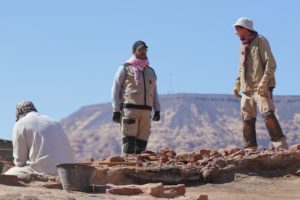
Dr Abdulrahman Alsuhaibani (middle), who is in charge of collections for the Royal Commission for AlUla, is shown at the Dadan archaeological site in northern Saudi Arabia. It was at Dadan that Dr. Alsuhaibani began his career as an archaeologist and developed his passion for preserving the region’s treasures. Royal Commission for AlUla
_______________________________
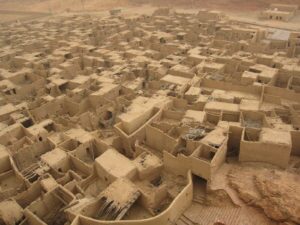
The old town of AlUla. Pteropus conspicillatus, CC BY-SA 3.0, Wikimedia Commons
_______________________________

The Lion Tomb site at AlUla. juhotski, (CC BY-SA 3.0), Wikimedia Commons
_______________________________
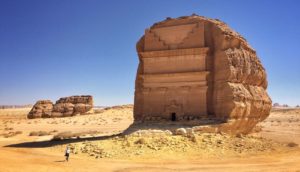
Qasr al Farid, tomb in the archaeological site Mada’in Saleh, AlUla. Richard.hargas, (CC BY-SA 4.0), Wikimedia Commons
_______________________________

Aerial view of AlUla. Sammy Six, (CC BY 2.0), Wikimedia Commons
_______________________________
And as for the question of whether Dhu Ghabbat was ‘the god of the forest’ or ‘the absentee’, I lean toward the latter view. In my opinion, he might well have been a lunar deity like Almakah, the moon god of the Sabaeans. When you think about it, the moon is often an absentee – a mysterious presence high above that gives rhythm to daily life as it waxes and wanes. Perhaps that is how it seemed to the Lihyanites. This is among the many stories we look forward to describing in more detail in years to come as we excavate, preserve and display the riches of AlUla as our gift to the world.
_______________________________
_______________________________
Cover Image, Top Left: Aerial view of Al’ Ula, by Sammy Six, (CC BY 2.0), Wikimedia Commons
Image, Second From Top, Right: This larger-than-life statue, excavated at the archaeological site of Dadan in north-west Saudi Arabia, has been dated to between the 5th and 3rd centuries BCE. It depicts a broad-shouldered man, possibly a king of that era. The statue featured in the exhibition AlUla: Wonder of Arabia in Paris in 2019-20. Royal Commission for AlUla
_______________________________




